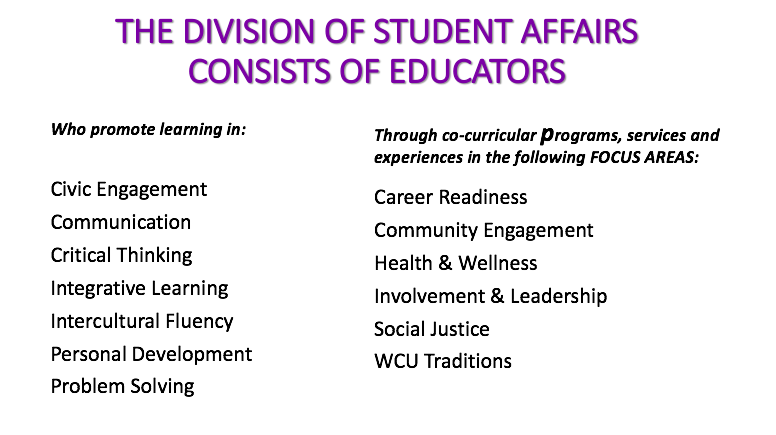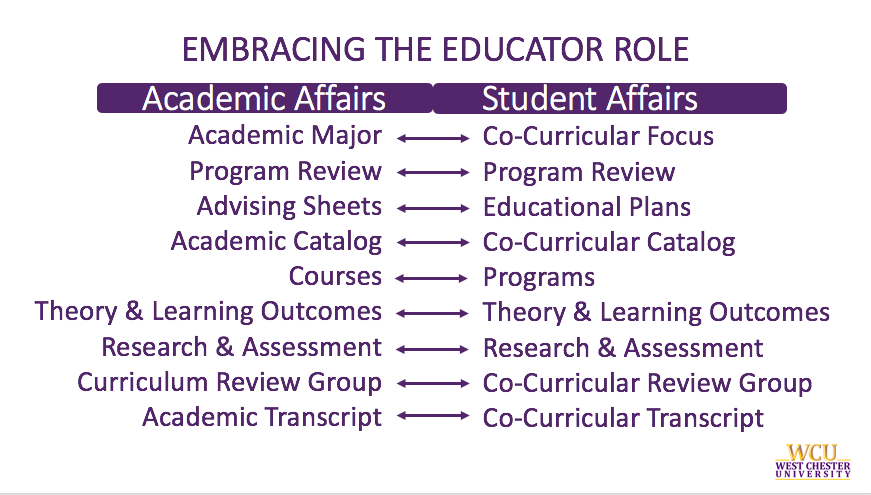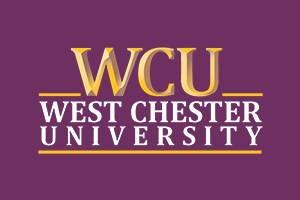Student Affairs Bridge Plan
The Student Affairs Bridge Plan is a short-term plan that guides our work until the next University strategic plan launches. As a division we are committed to the goals that directly align with completing the educational mission of the university. Click the image or read the drop down accordions below for more information.
Bridge Plan Priorities
- Ram Plan: Co-curricular Transcript
- Social Justice, Diversity, Equity and Inclusion
- Sharing Our Story
- Continuous Improvement
Bridge Plan Context
The plan was built with the following in mind:
- WCU & Student Affairs missions
- Current global, U.S. and PASSHE challenges
- Increased activism related to oppression and violence toward marginalized communities
- WCU's Moonshot for Equity initiative
- COVID-19 recovery period
- Largest WCU incoming class in history
- Projected decline in number of high school graduates across the U.S.
- Recent WCU re-organization
- Student Affairs external review recommendations
- Anticipation of a permanent VPSA in Fall 2024
Bridge Plan Initiatives
Our Journey Through 2020
All members of our division were invited to contribute to the development of the strategic plan. Like our work, our strategic plan continues to evolve based on the needs of our division and our stakeholders.
Engagement & Experiential Learning
Goal Statement: Develop intentional and varied opportunities for students to engage on campus and within the broader community.
Outcomes:
- Leverage technology/multimedia platforms to engage students, communicate our programs and services, and provide learning opportunities.
- Develop stronger mutually beneficial partnerships with our internal and external stakeholders in order to better engage our students in learning opportunities.
Health, Wellness, and Safety
Goal Statement: Promote the comprehensive health, wellness, and safety of all students to create a community of care.
Outcomes:
- Provide education, training, and treatment for students regarding healthy living.
- Provide coaching to students regarding impact of decisions related to health, wellness, and safety to recognize and encourage personal accountability.
Infrastructure
Goal Statement: Promote responsible stewardship of human, fiscal, and physical resources needed to achieve success for our departments and to ensure the standards of our profession.
Outcomes:
- Expand existing and establish new funding sources.
- Provide training and professional development opportunities for staff of all levels (paraprofessional, support, entry, middle, and senior).
- Engage in long-range planning to ensure sustainability.
Social Justice
Goal Statement: Create an environment that understands, recognizes, and embraces social justice as a primary component of the campus community.
Outcomes:
- Infuse social justice knowledge into the policies, programs, and services to positively impact campus climate and beyond.
- Provide professional development for all Student Affairs staff, paraprofessionals, and students on how to understand and think critically about systems of oppression, privilege and equity.
- Conduct policy and practice reviews to identify and challenge formal and informal systems of oppression that might exist within.
- Analyze current data to identify salient areas and holes within the campus climate.
Student Development (Success)
Goal Statement: Create an environment of outcome/evidence-based practices and data informed decision making to engage our diverse student population and impact student success.
Outcomes:
- Utilize WCU’s Student Affairs Learning Domains to inform Student Affairs’ programs and services that contribute to student success from orientation through graduation and beyond.
- Utilize data and assessment results for program improvement.



